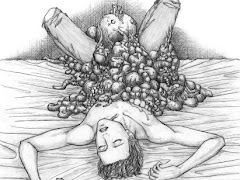This list contains really unnerving text, and some swearing! The only way this could EVER be work-safe, is if you work at a side-show in a circus! The items on this list are in no particular order.
[WARNING: contains adult material which is not safe for work]
Teratophilia
Teratophilia is the sexual attraction to deformed or monstrous people. One version of Teratophilia is acrotomophilia, sexual attraction to amputees. Considerable commercial and amateur erotica is published apparently targeting people with such a sexual attraction. Persons attracted to amputees in particular are said to be engaging in amputee fetishism.
Emetophilia
Also known as Erotic Vomiting
Talk about blowing chunks! Obviously, the words “erotic” and “vomiting” are not often used together. However, they do have similarities: Both trigger the release of hormones that make you feel better; both are caused by stimulus; and, for men at least, both involving having fluids get forced through a tube and out of an orifice. The primary dissimilarity is that most people do not associate throwing-up with a pleasurable experience. Dr. Robert J. Stoller, a renowned sexologist and psychiatrist, begs to differ; Here he discusses the cases of three women: The first woman doesn’t do the Technicolor-yawn herself, instead, “…I can reach a sure orgasm by imagining someone vomiting in a hard, humiliating fashion…”; The second woman actually experiences an orgasm every time she throws up; The third and final woman describes it like this: “…Vomiting for me is like…an orgasm in that I’m tensed, I feel the…intense flood of good feelings almost continually throughout the vomiting and experience relief and quiet warmth in my body when I’m finished. It is not identical to an orgasm. I do not feel it intensely in my genitals alone, but I do feel it there as well as the rest of my body and…in my mouth…”. NOTE: There is also a practice known as “Roman-showers”, which is to become aroused by being vomited upon.
Autopederasty
Autopederasty is the near-impossible act of sticking one’s own fully-erect penis in one’s own rectum. Yes. Only a small percentage of people can do it, but it’s possible! There is a porno called “Go Fuck Yourself” that is devoted to the act, even going so far as to instruct people on how to do it!
NOTE: There are two other, more familiar variants: Autofellatio is when a man gives himself oral sex; Then, there is Autocunnilingus, where a woman gives herself oral sex.
Mummification
Mummification as a BDSM bondage practice involves restraining a living person’s body in a non-damaging way by wrapping it head to toe, or neck to toe, in materials like saran wrap, clingfilm, cloth, bandages, rubber strips, duct tape, plaster bandages, bodybags, or straitjackets. The end result is a person completely immobilized and looking like an Egyptian mummy. They may then either be left bound in a state of effective sensory deprivation for a period of time, or sensually stimulated in their state of bondage, before being released from their wrappings.
Salirophilia
Salirophilia is a sexual fetish or paraphilia that involves deriving erotic pleasure from soiling or disheveling the object of one’s desire, usually an attractive person. It may involve tearing or damaging their clothing, covering them in mud or filth, or messing their hair or makeup. The fetish does not involve harming or injuring the subject, only their appearance. The fetish sometimes manifests itself in the defacing of statues or pictures of attractive people, especially celebrities. The fetishist finds this sexually exciting, rather than mere vandalism. They sometimes form collections of defaced art for future enjoyment.
Pseudonecrophilia
Unlike real necrophilia, this is actually legal (not that that’s a good thing)! It’s quite simple, actually: One partner remains quiet (something we all wish we could have) and still, while the other has sex with him/her. For added realism, the “pseudo-dead” partner can lay in cold water for a while before the act! This particular practice met some notoriety, thanks to its appearance in the show, “Law and Order: Special Victims Unit”.
Cannibal Fantasies
These fantasies are obviously pretty explanatory. On the Deviant Desires website (based on the book of the same name), Katharine Gates explains that some people actually bring these fantasies to life in consensual role-playing! One of her friends, “…painted the woman’s nude body with dotted lines to represent cuts of meat.” One very tasteful website, Muki’s Kitchen, features photographs of female models trussed up in pans filled with vegetables, and stuffed with apples and carrots in every possible orifice. Thus, erotic feeding, messy fun, bondage, gags and vaginal or anal penetration may be incorporated into this practice.
Ponyplay
Ponyplay is a form of bondage that involves a “pony” and a rider. The pony is often outfitted with straps, a leather saddle, blinders, reins, and a bit in the mouth. The rider, sometimes utilizing either a riding crop or a whip, either gets pulled in a cart or rides the pony directly. The principal theme of animal roleplay is usually the voluntary or involuntary reduction (or transformation) of a human being to animal status, and focus on the altered mind-space created. The most common examples are probably canids (pup, dog, wolf), felines (cat, kitten, lion) or equines (pony, horse).
Nyotaimori
Nyotaimori (female body presentation), often referred to as “body sushi,” is the practice of eating sashimi or sushi from the body of a woman, typically naked. Nantaimori refers to the same practice using a male model. This sexual fetish is a subdivision of food play. As a result of being served on a human body, the temperature of the sushi or sashimi comes closer to body temperature. Before becoming a living sushi platter, the person is trained to lie down for hours without moving. She or he must also be able to withstand the prolonged exposure to the cold food. Body hair, including pubic hair, would also be shaved, as a display of pubic hair may be seen as a sexual act. Before service, the individual would take a bath using a special fragrance-free soap and then finish off with a splash of cold water to cool the body down somewhat for the sushi.
Agalmatophilia
Agalmatophilia is a paraphilia concerned with the sexual attraction to a statue, doll, mannequin or other similar figurative object. The attraction may include the desire for actual sexual contact with the objects, a fantasy of having sexual (or non-sexual) encounters with the animate or inanimate instances of the preferred objects, the act of watching encounters between the objects themselves, or sexual pleasure gained from thoughts of being transformed or transforming another into the preferred object. Agalmatophilia may also encompass Pygmalionism which describes a state of love for an object of one’s own creation.
READ MORE: Most Bizarre Accidents In World History
[Source]
[WARNING: contains adult material which is not safe for work]
Teratophilia
Teratophilia is the sexual attraction to deformed or monstrous people. One version of Teratophilia is acrotomophilia, sexual attraction to amputees. Considerable commercial and amateur erotica is published apparently targeting people with such a sexual attraction. Persons attracted to amputees in particular are said to be engaging in amputee fetishism.
Emetophilia
Also known as Erotic Vomiting
Talk about blowing chunks! Obviously, the words “erotic” and “vomiting” are not often used together. However, they do have similarities: Both trigger the release of hormones that make you feel better; both are caused by stimulus; and, for men at least, both involving having fluids get forced through a tube and out of an orifice. The primary dissimilarity is that most people do not associate throwing-up with a pleasurable experience. Dr. Robert J. Stoller, a renowned sexologist and psychiatrist, begs to differ; Here he discusses the cases of three women: The first woman doesn’t do the Technicolor-yawn herself, instead, “…I can reach a sure orgasm by imagining someone vomiting in a hard, humiliating fashion…”; The second woman actually experiences an orgasm every time she throws up; The third and final woman describes it like this: “…Vomiting for me is like…an orgasm in that I’m tensed, I feel the…intense flood of good feelings almost continually throughout the vomiting and experience relief and quiet warmth in my body when I’m finished. It is not identical to an orgasm. I do not feel it intensely in my genitals alone, but I do feel it there as well as the rest of my body and…in my mouth…”. NOTE: There is also a practice known as “Roman-showers”, which is to become aroused by being vomited upon.
Autopederasty
Autopederasty is the near-impossible act of sticking one’s own fully-erect penis in one’s own rectum. Yes. Only a small percentage of people can do it, but it’s possible! There is a porno called “Go Fuck Yourself” that is devoted to the act, even going so far as to instruct people on how to do it!
NOTE: There are two other, more familiar variants: Autofellatio is when a man gives himself oral sex; Then, there is Autocunnilingus, where a woman gives herself oral sex.
Mummification
Mummification as a BDSM bondage practice involves restraining a living person’s body in a non-damaging way by wrapping it head to toe, or neck to toe, in materials like saran wrap, clingfilm, cloth, bandages, rubber strips, duct tape, plaster bandages, bodybags, or straitjackets. The end result is a person completely immobilized and looking like an Egyptian mummy. They may then either be left bound in a state of effective sensory deprivation for a period of time, or sensually stimulated in their state of bondage, before being released from their wrappings.
Salirophilia
Salirophilia is a sexual fetish or paraphilia that involves deriving erotic pleasure from soiling or disheveling the object of one’s desire, usually an attractive person. It may involve tearing or damaging their clothing, covering them in mud or filth, or messing their hair or makeup. The fetish does not involve harming or injuring the subject, only their appearance. The fetish sometimes manifests itself in the defacing of statues or pictures of attractive people, especially celebrities. The fetishist finds this sexually exciting, rather than mere vandalism. They sometimes form collections of defaced art for future enjoyment.
Pseudonecrophilia
Unlike real necrophilia, this is actually legal (not that that’s a good thing)! It’s quite simple, actually: One partner remains quiet (something we all wish we could have) and still, while the other has sex with him/her. For added realism, the “pseudo-dead” partner can lay in cold water for a while before the act! This particular practice met some notoriety, thanks to its appearance in the show, “Law and Order: Special Victims Unit”.
Cannibal Fantasies
These fantasies are obviously pretty explanatory. On the Deviant Desires website (based on the book of the same name), Katharine Gates explains that some people actually bring these fantasies to life in consensual role-playing! One of her friends, “…painted the woman’s nude body with dotted lines to represent cuts of meat.” One very tasteful website, Muki’s Kitchen, features photographs of female models trussed up in pans filled with vegetables, and stuffed with apples and carrots in every possible orifice. Thus, erotic feeding, messy fun, bondage, gags and vaginal or anal penetration may be incorporated into this practice.
Ponyplay
Ponyplay is a form of bondage that involves a “pony” and a rider. The pony is often outfitted with straps, a leather saddle, blinders, reins, and a bit in the mouth. The rider, sometimes utilizing either a riding crop or a whip, either gets pulled in a cart or rides the pony directly. The principal theme of animal roleplay is usually the voluntary or involuntary reduction (or transformation) of a human being to animal status, and focus on the altered mind-space created. The most common examples are probably canids (pup, dog, wolf), felines (cat, kitten, lion) or equines (pony, horse).
Nyotaimori
Nyotaimori (female body presentation), often referred to as “body sushi,” is the practice of eating sashimi or sushi from the body of a woman, typically naked. Nantaimori refers to the same practice using a male model. This sexual fetish is a subdivision of food play. As a result of being served on a human body, the temperature of the sushi or sashimi comes closer to body temperature. Before becoming a living sushi platter, the person is trained to lie down for hours without moving. She or he must also be able to withstand the prolonged exposure to the cold food. Body hair, including pubic hair, would also be shaved, as a display of pubic hair may be seen as a sexual act. Before service, the individual would take a bath using a special fragrance-free soap and then finish off with a splash of cold water to cool the body down somewhat for the sushi.
Agalmatophilia
Agalmatophilia is a paraphilia concerned with the sexual attraction to a statue, doll, mannequin or other similar figurative object. The attraction may include the desire for actual sexual contact with the objects, a fantasy of having sexual (or non-sexual) encounters with the animate or inanimate instances of the preferred objects, the act of watching encounters between the objects themselves, or sexual pleasure gained from thoughts of being transformed or transforming another into the preferred object. Agalmatophilia may also encompass Pygmalionism which describes a state of love for an object of one’s own creation.
READ MORE: Most Bizarre Accidents In World History
[Source]

























































